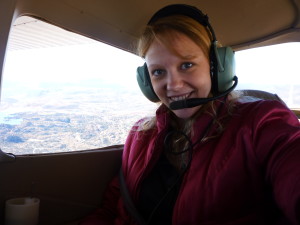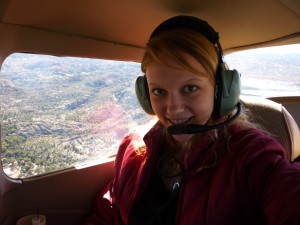
Me in the back seat of the Cessna 172S single engine aircraft flying over the Granite Dells of Prescott.

The type of aircraft I flew in with Granite Mountain in the background.
One of the unique advantages of attending Embry-Riddle Aeronautical University is the ability to do free observer flights in small aircraft. Although I am almost half-way through my fourth year at this university, I had never taken advantage of this opportunity. After mentioning this to my friends, I was surprised to find out how few of my fellow non-flight student friends had actually taken an observer flight.
Since I was staying on campus for Thanksgiving, and I had a day off (a rare occurrence for seniors studying engineering), I decided to give the observer flight a shot.
I arrived at the flightline at 9 a.m. on the Saturday after Thanksgiving, the time recommended by the dispatcher on duty. Due to the low amount of traffic on the holiday weekend, I waited until 10:45 a.m. when an instructor and student agreed to allow me to fly with them.
The flight I observed was a one hour private pilot training flight with student Stan Westerman and instructor Lorne Trapani in a single-engine Cessna 172S.
Before my observer flight, the smallest aircraft I had flown in was a regional airliner. I’d heard several things about the difference between commercial flights I’d taken and what to expect from a small aircraft. I’d heard that I was going to be crushed in the back seat and that a commercial flight with turbulence was going to be nothing compared to what I’d experience in a single-engine aircraft.
I was pleasantly surprised to find that in my experience, neither of those cases were true. There was plenty of leg room and I found the level of turbulence about equivalent to a commercial flight. The flight in general was very enjoyable.
After a quick passenger briefing, I buckled my seat belt and eagerly awaited take-off. The instructor and student pilot adjusted the flaps and discussed cross wind as they prepared for the flight. As I sat in the back of the plane, I couldn’t help but think that it didn’t feel very different from sitting in an idling car.
The plane left the runway into a cloudless blue sky. Just after take-off we were flying over the university with beautiful views of the Granite Dells and Granite Mountain. We then banked to fly over Glassford Hill and approached Mingus Mountain. Our horizon quickly became the red rocks of Sedona and the snow-covered peaks of Flagstaff as we flew over Mingus Mountain.
I wasn’t really ready when the plane touched back down; the flight could have lasted another hour. The vistas were well worth the wait.

 A View of Campus from the air.
A View of Campus from the air.

The Granite Dells and Willow Creek across from campus

Glassford Hill between Prescott and Prescott Valley

Granite Mountain from just after take off.

In the foreground you can see Mingus Mountain. Behind that, you can see the red rocks of Sedona. In the distance you can see the white-capped mountain of Flagstaff.



